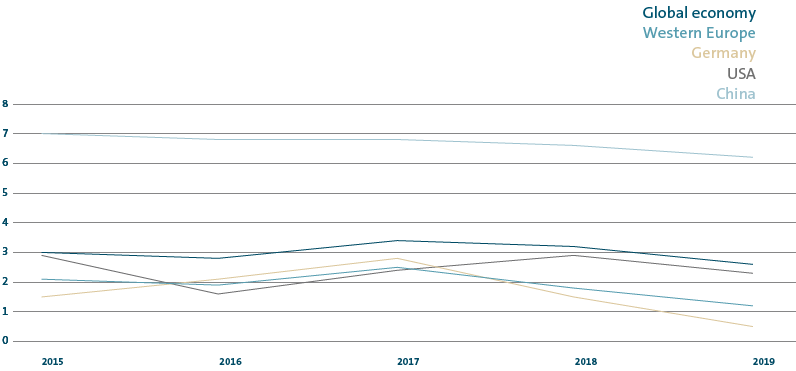Business Development
The robust growth of the global economy continued in fiscal year 2019 with a decrease in momentum. Global demand for vehicles was lower than in the previous year. Amid persistently challenging market conditions, the Volkswagen Group delivered 10.97 million vehicles to customers.
DEVELOPMENTS IN THE GLOBAL ECONOMY
The global economy sustained its robust growth in 2019 with a decrease in momentum: global gross domestic product (GDP) rose by 2.6 (3.2)%. Economic momentum weakened compared with the previous year, both in advanced economies and emerging markets. With interest rates remaining comparatively low and prices for energy and other commodities falling year-on-year on the whole, consumer prices also declined worldwide. Growing upheaval in trade policy at international level and continuing geopolitical tensions led to much greater economic uncertainty and resulted in a wane in the international trade of goods.
Europe/Other Markets
GDP growth in Western Europe slowed to 1.2 (1.8)% as the year went on. The rate of change in nearly all countries in northern and southern Europe declined compared with the previous year. The uncertain outcome of the Brexit negotiations between the United Kingdom and the European Union (EU) continued to generate uncertainty, as did the related question of what form this relationship would take in the future. The unemployment rate in the eurozone continued to decrease, falling to an average of 7.5 (8.1)%, though rates remained considerably higher – albeit declining – in Greece and Spain.
At 2.3 (3.3)%, the Central and Eastern Europe region also recorded a slower growth rate in the reporting period than in the previous year. In Central Europe, GDP growth tapered off at a relatively high level. Economic growth in Eastern Europe was also weaker. Lower prices for energy and other commodities led to a deterioration in the economic situation of the individual countries from this region that export raw materials. At 1.1 (2.2)%, the growth of the Russian economy, the region’s largest economy, halved compared with the previous year.
The Turkish economy showed a slightly positive rate of change of 0.5 (2.9)%. Increased tariffs along with the depreciation of the Turkish lira, which was accompanied by very high inflation, led to a decline in purchasing power. South Africa’s GDP rose by just 0.2 (0.8)% in the reporting period, down further on the already low figure for the prior period. Ongoing structural deficits, social unrest and political challenges weighed on the economy.
Germany
Germany’s GDP continued to grow in 2019 on the back of the strong labor market, though momentum diminished markedly year-on-year to 0.5 (1.5)%. Both business and consumer sentiment darkened further as the year progressed.
North America
Economic growth in the USA declined in the reporting period, reaching 2.3 (2.9)%. The economy was supported mainly by domestic consumer demand. The unemployment rate in the United States was at 3.7 (3.9)%. Given the global uncertainty, the US Federal Reserve lowered its key rate amid relatively steady inflation, thus reversing the tightening of monetary policy it had initiated in the meantime. The US dollar gained strength against the euro in the course of the year. Growth in Canada decreased to 1.6 (2.0)%, while the Mexican economy stagnated at a rate of 0.1 (2.1)%.
South America
Brazil’s economy once again recorded only slight growth, at 1.1 (1.3)%. The situation in South America’s largest economy remained tense due to political uncertainty, among other factors. The economic situation in Argentina deteriorated further as the year went on. Amid continuing high inflation and at the same time considerable devaluation of the local currency, the country remained in recession, with GDP falling by 2.6 (−2.5)%.
Asia-Pacific
At 6.2 (6.6)%, China’s economy recorded a growth rate at a high level in 2019, but its rate of expansion was slightly lower than in the previous year. Government support provided in response to the trade policy dispute between China and the US continued in the course of 2019. The Indian economy saw growth of 4.8 (6.8)% in the reporting period. Japan’s GDP grew by only 1.1 (0.3)%.
ECONOMIC GROWTH
Percentage change in GDP

EXCHANGE RATE MOVEMENTS FROM DECEMBER 2018 TO DECEMBER 2019
Index based on month-end prices: as of December 31, 2018 = 100
